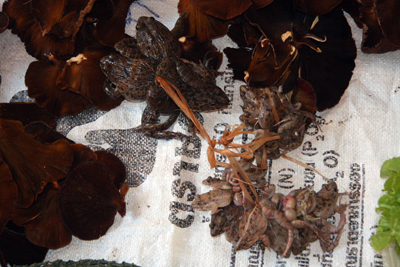
Frog lunch for a snake in Taman Negara, Malaysia. Photo by R. Butler
|
|
The consumption of up to one billion frogs per year to satisfy human appetite for frog flesh is adding to the litany of pressures on global amphibian populations, write researchers in the upcoming issue of Conservation Biology.
Examining U.N. data on the international trade in frog legs, authors Ian G. Warkentin, David Bickford, Navjot S. Sodhi, and Corey J. A. Bradshaw report that frog consumption appears to be on the rise, putting some species at risk of overexploitation. The United States, the European Union (led by France), and a handful of Asia nations are the largest importers of frog meat.
“The frogs’ legs market has shifted from seasonal harvest for local consumption to year-round global trade,” the scientists write. “Markets in the United States and France were initially supplied by domestic harvest to serve a seasonal demand, but overexploitation led to decline or loss of commercial stocks. By the time these local sources disappeared, improved food-freezing technology enabled international markets to be tapped for North American and European demand, most notably in Asia.”
According to New Scientist, which reported on the paper, the authors estimate that 180 million to over a billion frogs are harvested each year from the wild to meet demand. Efforts to farm frogs have met limited success.
The researchers conclude by proposing a certification process, with monitoring and reporting systems, to ensure sustainable harvesting of frogs from the wild.
“Such a program would greatly enhance our monitoring and harvest-modeling capacity by providing a structure for the collection of necessary demographic data, which would in turn promote development of a sustainable frog-harvesting industry,” they write.
The authors suggest the initiative be funded by wealthy consuming countries.
 Frogs for sale in a Lao market |
“It is the moral duty and responsibility of importing, developed countries to assist with such a program’s implementation because many frog-exporting countries lack the necessary institutional capacity and financial resources.”
Amphibians face a barrage of threats beyond over consumption by humans including pollution, the introduction of alien species, habitat destruction, an outbreak of a deadly fungal disease, and climate change. According to the Global Amphibian Assessment, a comprehensive survey of the world’s 6,000 known species of frogs, toads, salamanders, newts and caecilians, about one-third of amphibians are classified as threatened with extinction.
CITATION: Warkentin, I.G. et al. Eating Frogs to Extinction. Conservation Biology. DOI: 10.1111/j.1523-1739.2008.01165.x